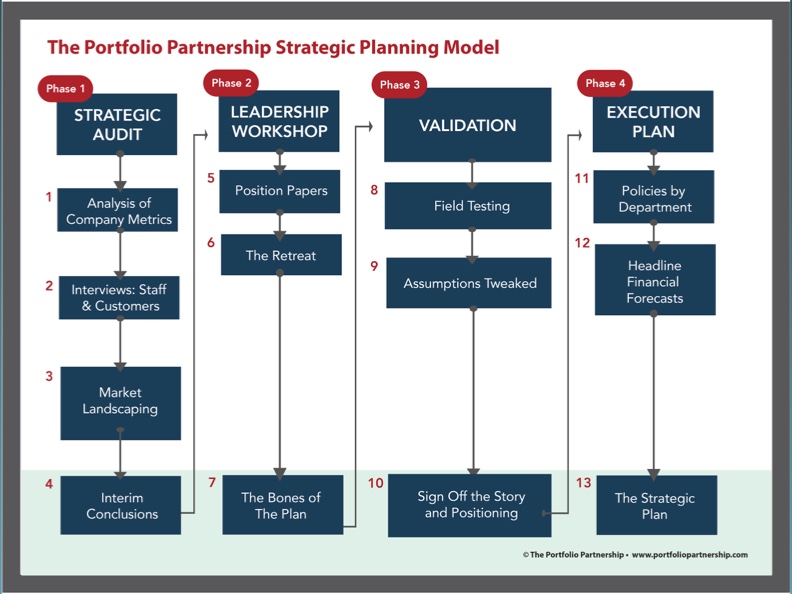The Strategic Plan sounds like a big company tool, the sort of thing that IBM or Google might pull together. Well these companies have become “Pillar” companies for a reason. They plan and execute. They zoom out and zoom in (Jim Collins).
Middle market companies would all gain tremendous benefit from building a Strategic Plan. Why? It creates the one thing often missing from entrepreneurship – alignment. It brings meaning to all of the activities of your team. It synchronizes corporate objectives with departmental objectives. That’s why Strategic Plans are the best “tactical” weapon at your disposal. But if you’re not prepared to put your heart and soul into them, forget it. If you are not prepared to ensure that they’re embedded in the reality of your situation, save your time and money and spend it on another product launch or marketing campaign!
This is our little process map, our Playbook, to produce compelling Strategic Plans. Of course the question remains do you have the time and resources to do them quickly and well?
The Narrative
- Analysis of Metrics – You need to really examine the evidence with an open mind. Marketing, Sales, Competitors, Customer Support, Unit Sales, Employee Turnover, Margins. Everything that gets measured needs to be reviewed.
- Interviews – Insights from managers and customers are often very insightful. What you are really good at? What would customers miss if you were gone tomorrow? What business do they think you are in? What sales and marketing strategies are working?
- Market Landscaping – Understand how big your market segments are. Understand the strength and weaknesses of your competition. What are the big drivers affecting your sector? e.g. Medical Device Tax, IoT developments, the impact on you from recent mergers, changes to privacy policies, lack of skilled engineers etc. Consider commissioning fresh research from an a specialist outside agency.
- Interim Conclusions – What is this discovery project telling you? What opportunities have we missed? What projects are failing?
- Position Papers – The key to a successful off-site huddle of senior management is………preparation! Request key position papers are drawn up by each member of the inner cabinet. You will need to curate possible position papers down from a long list. Maximum number of papers should be around six but ideally three. Examples could include: Should we build our own technology instead of re-selling third party? Should we grow by acquisition? What business do we want to be in and how do we get there? How could we restructure our talent to be more effective and relevant to our customers? What is the best financial strategy for the group?
- The Retreat – Attendees, chairmanship, location all need to be thought through carefully. If not professionally managed these events can turn into personal battles between managers. By doing as much homework upfront and circulating around the team, it should be possible to deliver a high quality debate and importantly, sign off on the key position papers.
- The Bones of the Plan – The output from the Retreat should allow an appointed project team to come up with an advanced version of the story behind the new Strategic Plan. This will contain the broad strokes of the businesses you want to scale and the overall execution plan. It will not contain detailed policies at this stage.
- Field Testing – It’s important to stress test this thinking. Get your thinking in front of customers and partners you trust. Socialize the ideas amongst key managers. Are you really capable of winning? Can you excel at this strategy? Why would you fail? Can the balance sheet scale in accordance with the plan?
- Assumptions tweaked – Inevitably ideas will be shaped by contact with the real world. Value propositions will require re-calibrating. Missing skillsets will be identified. Funding gaps may appear? Acquisition targets may not exist in practice, but seemed a good idea on paper. Acquisitions rarely deliver value in the eyes of the acquirer. Treat yourself and your team to a short book to improve the odds.
- Sign off – All this work should allow the project team leader to draft a credible, stretching and motivating new strategic positioning and plan. This will form the canvas for detailed policy making.
- Policies by department – Positioning drives everything. Knowing where you are going is crucial! Who you are is what you measure. Who you are determines the marketing narrative, web site, and collateral. Who you are attracts talent and frames the story you tell new recruits. Only when strategic positioning is complete, can one build a credible set of tactics.
- Financial Forecasts – People get confused with the word Plan. They think of financial numbers. They think of cash flows and profits. Financial forecasts are a corollary of great policies. They flow from a set strategic desires. This will be an iterative process until both the desired policies and the numbers are aligned. Compromise will be needed.
- The Strategic Plan – Capturing all of this work in one document is important. It must be a document that employees can believe in. It is a leadership statement. It will ensure that all operational playbooks and tactics are anchored in context. It should drive the alignment of all activity to ensure the business fulfils its potential.
Remember there’s never a bad time to do a strategic plan. As Jim Collins once said in his series of great books, really successful companies over long periods of time, become superb at zooming out and zooming in. Strategic Planning is essential for all companies, not just big ones.
The Portfolio Partnership project manages all aspects of Strategic Planning for clients. Please contact us to discuss timetable and our fixed cost.









